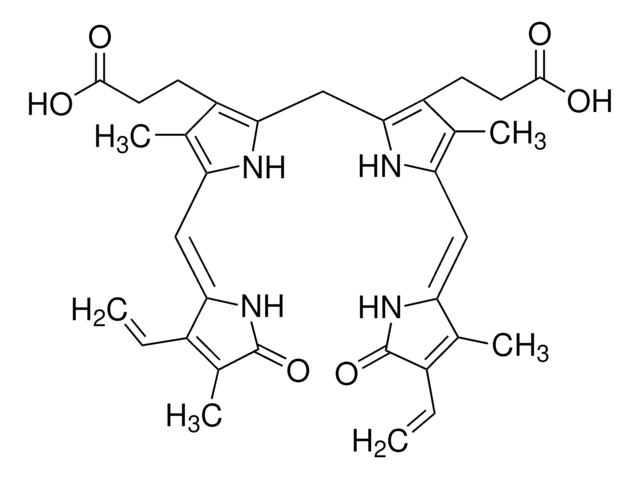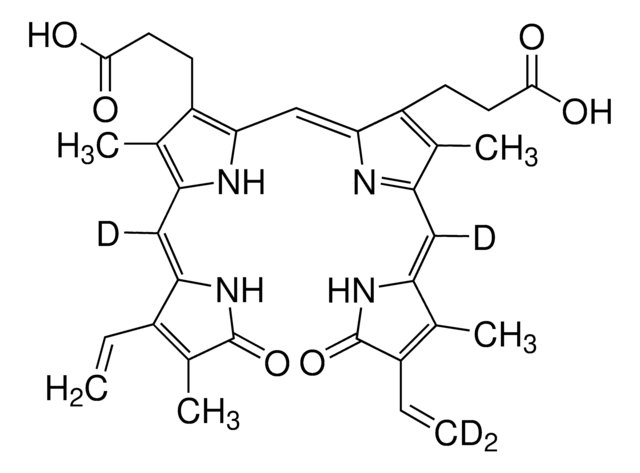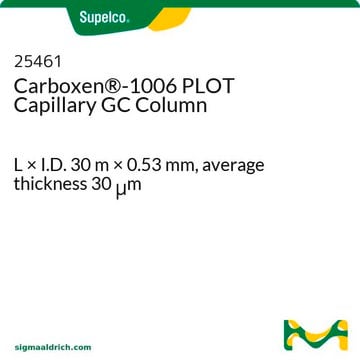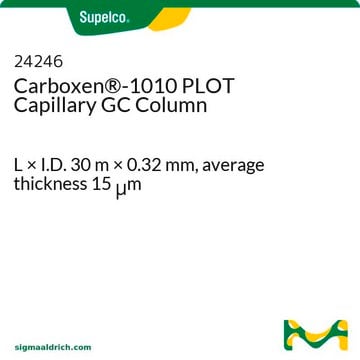30891
Biliverdin -hydrochlorid
≥97.0% (TLC)
Synonym(e):
Biliverdin
About This Item
Empfohlene Produkte
Assay
≥97.0% (TLC)
Form
powder or crystals
Anwendung(en)
metabolomics
vitamins, nutraceuticals, and natural products
Lagertemp.
−20°C
SMILES String
Cl.CC1=C(C=C)C(\NC1=O)=C\c2[nH]c(/C=C3\N=C(\C=C4/NC(=O)C(C=C)=C4C)C(C)=C3CCC(O)=O)c(CCC(O)=O)c2C
InChI
1S/C33H34N4O6.ClH/c1-7-20-19(6)32(42)37-27(20)14-25-18(5)23(10-12-31(40)41)29(35-25)15-28-22(9-11-30(38)39)17(4)24(34-28)13-26-16(3)21(8-2)33(43)36-26;/h7-8,13-15,35H,1-2,9-12H2,3-6H3,(H,36,43)(H,37,42)(H,38,39)(H,40,41);1H/b26-13-,27-14-,28-15-;
InChIKey
KTRFJVRKVQROKS-UJCZHUFNSA-N
Verwandte Kategorien
Allgemeine Beschreibung
Anwendung
- as a treatment to J774A.1 cells to study its role in alternation of beta (β)-endorphins level
- as a commercial standard for the detection of biliverdin in mouse unstable and stable plaques tissues using liquid chromatography-tandem mass spectrometry (LC-MS-MS)
- to add to Fucci-containing cells to improve the mIFP signal
- to examine its impact on infrared fluorescent protein (iRFP) in some retinal preparations
Biochem./physiol. Wirkung
Verpackung
Signalwort
Warning
H-Sätze
Gefahreneinstufungen
Eye Irrit. 2 - Skin Irrit. 2 - STOT SE 3
Zielorgane
Respiratory system
Lagerklassenschlüssel
11 - Combustible Solids
WGK
WGK 3
Flammpunkt (°F)
Not applicable
Flammpunkt (°C)
Not applicable
Analysenzertifikate (COA)
Suchen Sie nach Analysenzertifikate (COA), indem Sie die Lot-/Chargennummer des Produkts eingeben. Lot- und Chargennummern sind auf dem Produktetikett hinter den Wörtern ‘Lot’ oder ‘Batch’ (Lot oder Charge) zu finden.
Besitzen Sie dieses Produkt bereits?
In der Dokumentenbibliothek finden Sie die Dokumentation zu den Produkten, die Sie kürzlich erworben haben.
Kunden haben sich ebenfalls angesehen
Unser Team von Wissenschaftlern verfügt über Erfahrung in allen Forschungsbereichen einschließlich Life Science, Materialwissenschaften, chemischer Synthese, Chromatographie, Analytik und vielen mehr..
Setzen Sie sich mit dem technischen Dienst in Verbindung.











